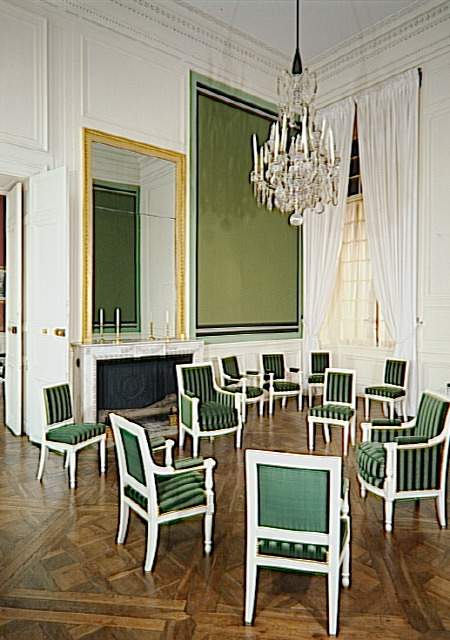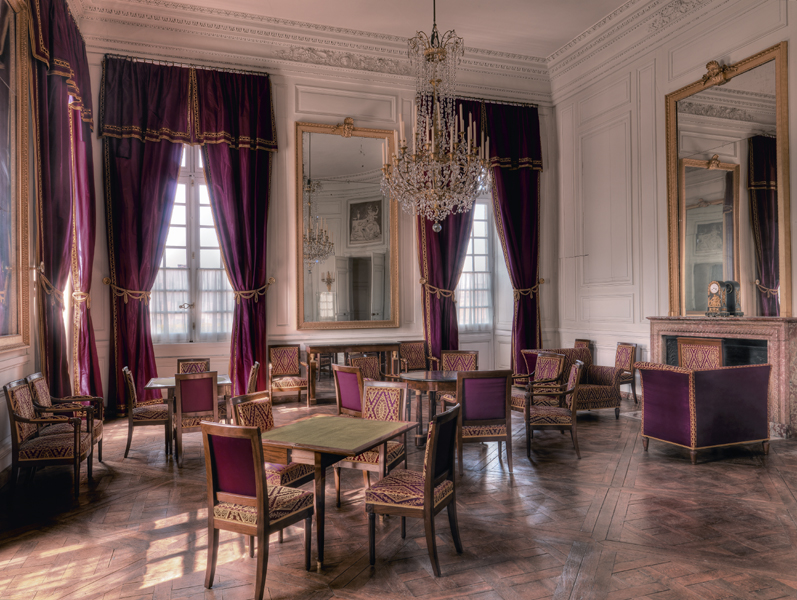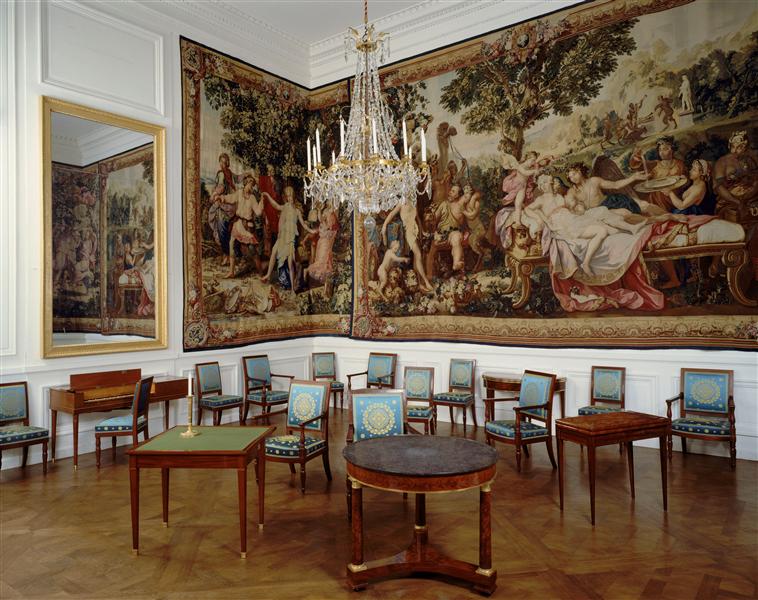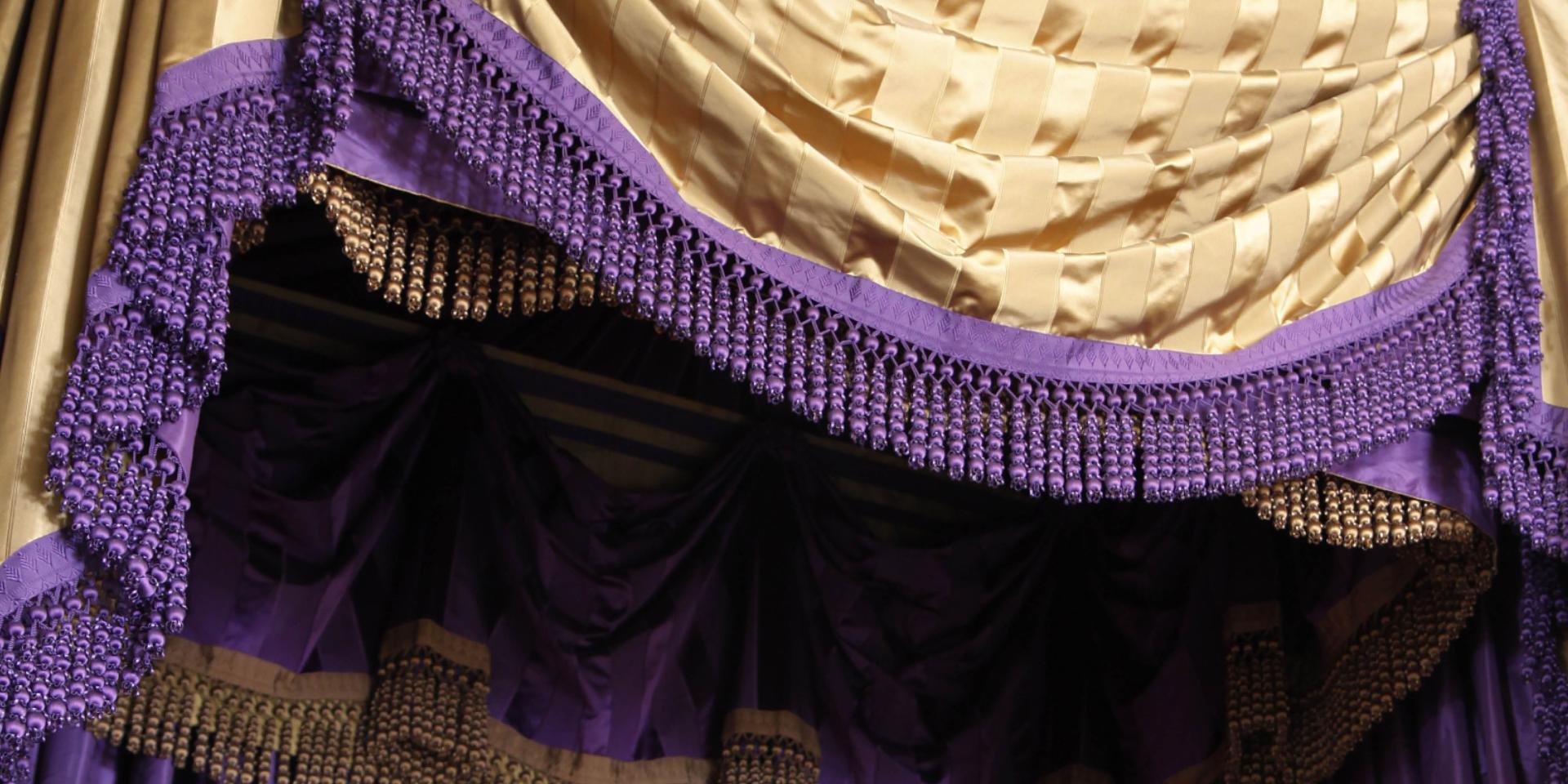Created during the First Empire, the Prince's Double Apartment is so named because it has two bedchambers.
In 1807, the former apartments of the future king of France, his Governor and his sister, Madame Royale, were used to create one larger apartment designed to welcome a royal couple. Comprising two bedrooms, the apartment became known as the Prince’s double apartment. As it was destined for a prince, it is not as richly furnished as the apartments of the monarchs. The furniture is not gilt wood, the textiles are less plush and some of the rooms are simply decorated with wallpaper.
- Visit the museums
-
Guided Tours
These visits are carried out by speakers from the Réunion des Musées Nationaux (extra charge in addition to entry fee)
Antechamber
Nowadays a museum exhibition space, this room, formerly the Guard Room for the Dauphin’s apartment, displays the 18th-century furniture held at Compiègne during the Ancien Régime:
- a nightstand by Gaudreaux made in 1739 for the Dauphin, son of Louis XV;
- two large chests of drawers with marquetry by Riesener, delivered in 1780 for Marie-Antoinette's private apartment;
- several seats including two armchairs and two chairs from the private study of Madame Elisabeth, Louis XVI’s sister.
On the walls are two tapestries from The Story of Don Quixote after Charles-Antoine Coypel, one depicting The Judgment of Sancho with the arms of the Duke of Penthièvre, Admiral of France, and the other with the royal monogram on the theme of Sancho’s Banquet.

Dining room
Soberly furnished, this room, decorated with wallpaper, contains painted wood seats, simple white cotton curtains and two mahogany consoles. In line with the 18th-century tradition, this dining room has no table: a simple tray placed on trestles, concealed by a tablecloth, was set up as needed.
On the walls are engravings based on The History of Alexander by Charles Le Brun.

First salon
Formerly the Salle des Nobles in the Dauphin’s apartment, it was used as a waiting room during the First Empire. Like the dining room, it is simply furnished with painted wood furniture and decorated with wallpaper.

Second salon
This is the former bedchamber of the Dauphin, son of Louis XVI, as shown by the dolphins facing each other on the lintel of the original white marble fireplace.
The furniture made by the Parisian cabinetmaker Pierre-Benoît Marcion includes two quadrille tables, thus making this room a games parlour under the First Empire. In the hierarchy of the succession of rooms, mahogany thus replaces painted wood, and silk replaces wallpaper. The technical skill used in the wall hanging in striped and shaded gold damask, with its much sought-after trompe-l'oeil effect, make it one of the most extraordinary creations of the early 19th-century Lyon workshops.

Circular Salon
Formerly the Dauphin’s study, this salon has retained its 18th-century décor with floor-to-ceiling wood panelling finished with an intricately sculpted cornice, overdoors depicting classical scenes inspired by the bas-reliefs of Herculaneum painted in monochrome tones by the artist Sauvage (1785-1786), and a fireplace in Languedoc marble from the former château.
This salon owes its name, used since the First Empire, to its semi-circular end, a clever architectural adjustment to the complex plan of the building adopted by the architect Le Dreux de La Châtre in several areas of the structure.
The mahogany furniture, delivered by the cabinetmaker Pierre-Benoît Marcion, features a tea table and two games tables, giving this room a dual role. In front of the fireplace are two small sofas or pommiers, particularly popular during the First Empire.

Large bedchamber
This room has retained its late 18th-century architectural décor as it was designed for the bedroom of Madame Royale, daughter of Louis XVI: floor-to-ceiling wood panelling painted white, and an intricate cornice in the simpler style adopted under the Ancien Régime for this summer residence.
The grisaille overdoors by the painter Sauvage, depicting Children's Games, were originally from Louis XVI’s Powder Room, and were placed in this room during the First Empire.
This room with an alcove, the only one of its kind in the main apartments of the château, was intended for a female sovereign or princess, while the husband occupied the "small bedchamber" - not as yet reconstructed - adjoining the Circular Salon. The alcove’s curtains made it possible to separate off this part of the room and to use the rest as a sitting room.
The choice of clashing colours makes this room one of the château’s boldest decorative achievements: purple and yellow ochre grosgrain in dark tones around the bed to evoke the night, contrasting with the golden yellow of the curtains on the windows where the light comes in
The mahogany furniture, supplied in 1808 by Jacob-Desmalter, included, in addition to the bed and its somno (nightstand), a chest of drawers, a washstand, a writing desk and partially gilded seats with openwork backs, claw feet and winged figure mounts.

Side Salon
The particularly rich sculpted décor by Randon and Beauvallet is a reminder that this room served as the large study of Madame Royale, daughter of Louis XVI and Marie-Antoinette. The overdoors, painted in grisaille by Sauvage, belong to the Children's Games series which formerly adorned the King's Powder Room. They were placed in this room during the First Empire.
Three tapestries from the hanging Sujets de la Fable [Mythological Subjects], after Jules Romain, woven at Gobelins between 1733 and 1741, form the wall decoration at the far end of the room. From left to right: The Dance of the Shepherds and Shepherdesses, The Wedding Feast of Psyche and The Dance of the Nymphs.
The mahogany furniture, stamped Jacob-Desmalter, combines tea tables, games tables (quadrille and bouillotte) and an Errard pianoforte (1803), making this room a sitting room with several functions.


